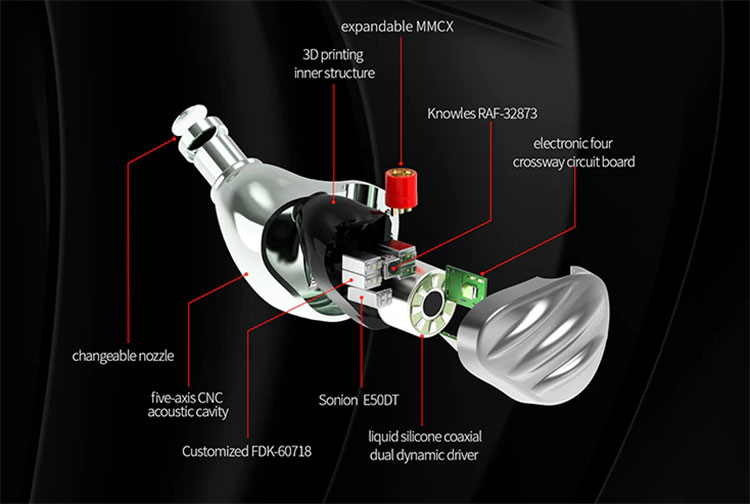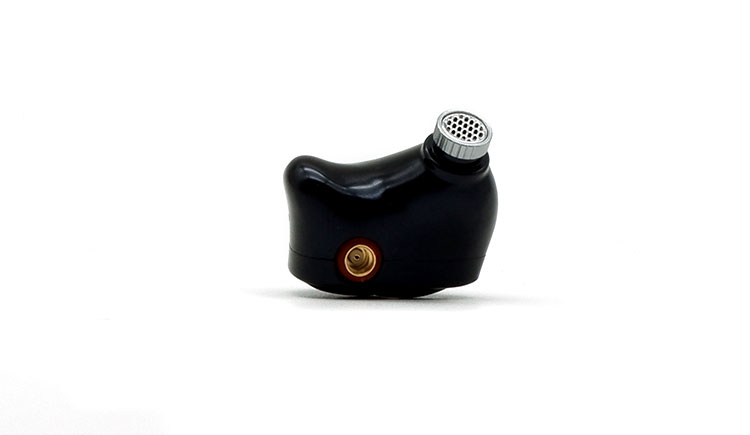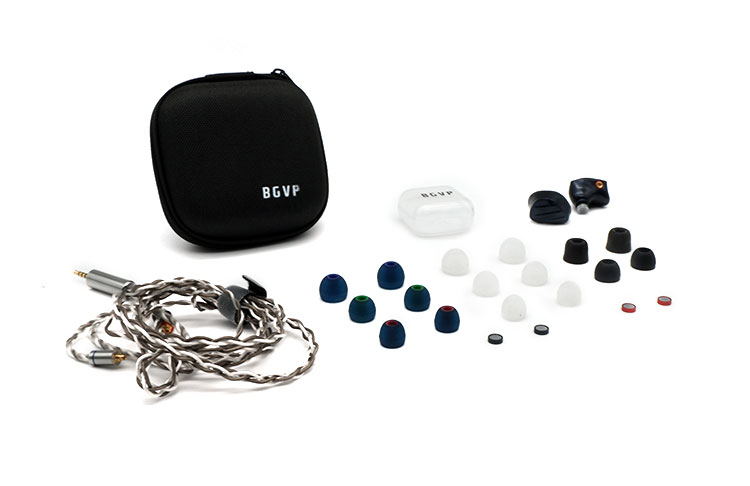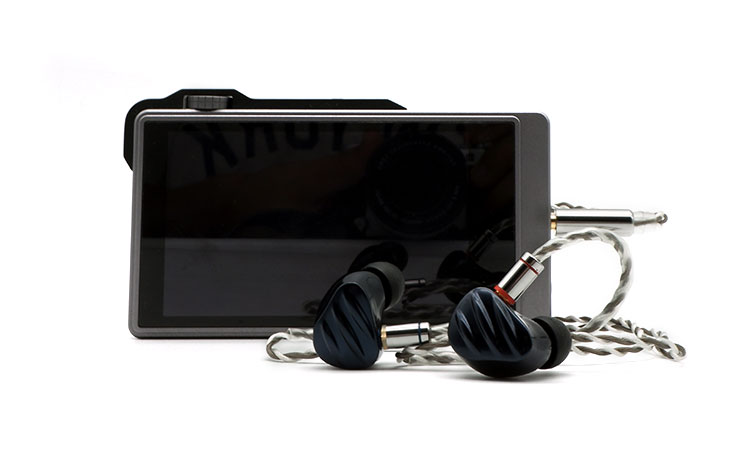The BGVP NS9 is a very affordable 9-driver hybrid IEM consisting of 2 dynamic drivers and 7 Knowles & Sonion BA drivers. It is priced at $169.
Disclaimer: The BGVP NS9 sent to us is a sample in exchange for our honest opinion in this review. We thank the team at HiFiGo and BGVP for giving us this opportunity.
You can read up on our previous BGVP reviews on Headfonics here.
Note, this 2-page review follows our new scoring guidelines for 2021 which you can read up on here.
BGVP is not new to the IEM market, being in the market since 2015. They have been producing great IEMs from the budget range to their current flagship multiple BA driver IEM, the DM8, which we’ve had the pleasure to evaluate earlier this year.
This time, BGVP has sent over their mid-range IEM, the densely packed 9-driver hybrid NS9. It would be interesting to see how it stacks up against the competition in the crowded under $200 market segment.

Tech Highlights
The NS9 features a 3D printed acoustic tube that has 3 channels in the sound tube to allow for isolation of each frequency range in the NS9. The shells are also equipped with tuning filters that allow the user to customize the frequency response.
Each shell contains a total of 9 drivers, 2 dynamic drivers, and 7 balanced armature drivers. The dynamic drivers have a titanium-plated silicone composite diaphragm. These diaphragms are powered by an N5 magnetic circuit with a CCAV voice coil. This combination allows the dynamic drivers to produce a deep and punchy bass response.
The 7 BA drivers are all sourced from either Knowles or Sonion. The lower midrange is handled by a pair of FDK-6018, which is a combination of 30017 and 60318, the upper mids are then handled by RAF-32783 units, and the treble frequencies are by 2 E50DT from Sonion.
This distribution of drivers into 4 groups means that the NS9 is equipped with a 4-way electronic crossover circuit. These crossover circuits are made with the highest grade components, including 8 high-precision Murata capacitors.
Design
The shells of the NS9 remind me of the FiiO FH3 because they look very similar. The NS9’s shells are made of aircraft-grade aluminum, that goes through a CNC machining process.
While they look very solid because they’re made of aluminum, the shells are surprisingly light, despite the higher driver count. The NS9 that was sent to us is the blue version, and the finishing is smooth and shiny.
Each of the NS9’s shells is connected with MMCX connectors, which are color-coded, so it would be very easy to properly attach the cable to the shells. The shells are equipped with a removable nozzle, and the stem of the IEMs has a lip that would ensure that most ear tips would stay in place once it’s attached to the NS9.
Cable
The cable that comes with the NS9 is a 5N silver-plated copper cable coated in PVC coating. The braiding is soft but doesn’t seem to tend to unravel too easily. The cables have an ear hook that stays in place so that it would be easier to put them on.
The terminations on the cable, both on the MMCX side, as well as the earphone side, are made of metal, so they seem to be resistant to wear. Each MMCX termination is color-coded with red and blue bands to make it easier to put them on at a glance.
The cables are just the right amount of stiffness, they are soft enough to avoid introducing any microphonics, while still being stiff enough to resist tangling.
Comfort and Isolation
With a total of 9 drivers and a 4-way crossover, I imagined that the NS9 would end up being heavy for a pair of IEMs. Fortunately, BGVP was able to keep the weight down, and it doesn’t weigh too much when I wear them.
The shells are designed by collecting numerous samples of ear data from custom IEMs, so the NS9 is designed with ergonomics in mind. This allows it to have a good fit, and I can confidently wear them for at least 2 hours without feeling any discomfort.
While the NS9 doesn’t insert particularly deep into my ears, I’m surprised that it seals well. Noise isolation is quite good, and when the music is playing, my surroundings disappear without giving me a closed-in feeling.
Package & Accessories
The NS9 arrives with a white sleeve that has a sketch of the IEMs, and some branding information. The inner box is a plain black box that says BGVP. Opening the box would show that BGVP provides tight foam inserts that snugly fit the IEMs, the carrying case, 3 types of ear tips, and the tuning filters.
The ear tips that come included with the NS9 are memory foam tips, and 2 types of silicone ear tips. 1 set is labeled as vocal ear tips that come in 3 sizes, small, medium, and large. The other set is labeled bass ear tips that come in small, medium, and large as well. The IEMs themselves also have a pair of ear tips attached to them when they arrive, so there are a total of 8 pairs of ear tips inside the box.
The cable, as well as the tuning filters, are all housed inside the semi-hard shell carrying case. The cable that arrived with us is terminated with a 2.5mm balanced. 3 pairs of tuning filters allow for tuning the frequency response of the NS9.
Sound Impressions
Most of my impressions were done with the silver filters and the stock ear tips. The difference between the available tuning options is explained in our synergy section on page 2.
Bass
My first impression of the NS9 is that it serves up piles and piles of bass. The NS9 is tuned to have generous amounts of bass, and for recordings that are mixed to be slightly more neutral, this gives the track much more energy.
The bass on the NS9 reached deep down into the sub-bass region, where it produces an environmental type of bass. The sub-bass is also not particularly rolled off even when compared to the elevated mid-bass region. It’s also very punchy and controlled, so it sounds like there is a subwoofer easily flooding the soundscape with sub-bass richness.
The midbass on the other hand is generally punchy, quick, and controlled. Drum hits end up very controlled, and each hit has the appropriate amount of attack, decay, and sustain. So each hit on the drum skins sounds very natural. Bass guitars on the other hand are presented with a flowy presentation while remaining textured.
With the more elevated bass region though, the NS9 can become muddy if the track is already particularly bass-focused, to begin with. This makes the bass bleed into the other frequencies.
Midrange
The vocal range is surprisingly very detailed and controlled. Although the vocal range doesn’t end up particularly euphonic, vocalists have this slightly breathy quality to them. So the vocals on the NS9 end up being strikingly detailed, particularly with vocal-centric tracks.
The pianos have an immediate sense of attack, and they tend to be very detailed. However, the pianos could do with a bit more fundamental weight. Guitars on the other hand tend to have a slightly brighter timbral tilt but still could use a bit more emphasis on the fundamental of each note.
With the 5 BA drivers handling the midrange, it remains very clear and presents midrange tones very accurately. However, the more emphasized bass region may overshadow the midrange when a vocal track plays at the same time as a bass-heavy passage.
Treble
On its own, the treble is crystalline. And it’s slightly elevated when the silver filter is used, which brings a slightly better tonal balance with the more elevated bass region. Cymbal hits are well defined and controlled, but still retains an appropriate amount of splash to give it a natural response.
Interestingly, when electronic music starts playing, and there is a more treble-focused passage, the notes are a bit more rounded. With passages that play treble-focused electronic notes, the edginess of the notes is slightly smoothed over.
While the treble is not going to outshine the more elevated bass region, the silver filter can shift the balance a bit to make the treble a bit closer to the bass’ elevation.
Staging
With a less airy presentation, the NS9 doesn’t have a particularly expansive soundstage. However, the images within the soundstage are spaced appropriately, and the images produced have enough clarity that they are distinct from each other.
Of course, the NS9 can create a coherent center image, however, that image is left well inside my head. I would have wanted a center image that was slightly pushed forward so that it would feel slightly more natural.
The general direction of the images can easily be perceived, however, there are dead spots between the extremes and the center image. So images that pan from left to right would sometimes disappear within those dead spots, and reappear on the other side.
Dynamics
With piano recordings, softer passages have a dainty quality to them. Allowing the pianist to properly convey the more somber atmosphere of the track through the NS9. Going into more exciting crescendos, the NS9 does just as well, where it can present an immediate sense of attack while having an obvious increase in loudness.
Click on Page 2 below for Synergy and Select Comparisons






